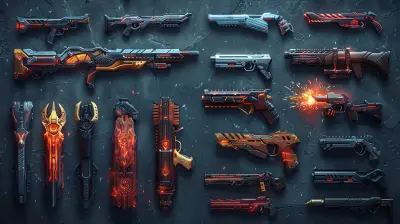The Importance of Transparency in Budgeting for Crowdfunded Games
10 October 2025
Crowdfunding has dramatically reshaped the gaming industry. It’s like a magic carpet ride for passionate game developers with big ideas but limited resources. Platforms like Kickstarter and Indiegogo allow creators to pitch their concepts directly to gamers and secure funding without relying on big-name publishers. It’s a win-win: developers get to pursue their creative vision, and backers feel like they’re part of something special from the ground up.
But here’s the kicker—crowdfunded games come with a unique responsibility. When people voluntarily shell out their hard-earned cash, they aren’t just paying for a product; they’re placing their trust in the developers. And one of the most significant ways developers can honor that trust is through transparent budgeting. Why? Well, let’s dive in.
What Does Transparency in Budgeting Even Mean?
Let’s start with the basics. Transparency in budgeting boils down to developers being upfront and honest about how they’re planning to spend the funds they collect. It’s not just saying, “Hey, we need $500,000 to make this game.” It’s breaking that number down like a detailed receipt.For instance, developers should specify how much of the budget will go toward game design, programming, art, marketing, shipping physical rewards, and other necessary expenses. Transparency is also about addressing potential risks. What could go wrong? How will you handle delays? It’s about giving backers a realistic idea of where their money is going and what challenges lie ahead.
Why Transparency is Non-Negotiable in Crowdfunding
1. Trust is Everything
When it comes to crowdfunding, trust is the currency. Backers are essentially funding an idea, not a finished product. It’s a gamble, and they know it. But no one wants to feel scammed. If a developer isn’t clear about how the funds will be used, backers are left wondering: “Are they prioritizing the game or splurging on first-class flights?” Transparency helps build trust and reassures backers that their money is being spent wisely.2. Avoiding Mismanaged Expectations
We’ve all heard the horror stories—games that raised millions but failed to deliver. Remember Mighty No. 9? It’s the poster child for crowdfunded projects gone wrong. A lack of clarity about budgets often leads to inflated expectations, and when a project fails to live up to the hype, backers are left disappointed. Developers who are upfront about their limitations and costs are far less likely to face backlash.3. Accountability Keeps Everyone Honest
Imagine if someone gave you $10,000 and told you to follow your dreams. Without accountability, it’s easy to lose focus or overspend. When developers make their budgets public, they’re effectively locking themselves into a financial plan. It’s not just about showing backers where the money is going—it’s about holding themselves accountable. Think of it as a map that keeps them on track.4. Encouraging Repeat Backers
Crowdfunding isn’t usually a one-and-done deal. Many developers return to platforms like Kickstarter for future projects. A developer who’s transparent and delivers on their promises is far more likely to retain loyal backers. Trust snowballs. On the flip side, developers who aren’t transparent risk damaging their reputation, making future crowdfunding efforts an uphill battle.
What Happens When Transparency is Missing?
What’s the worst that could happen if developers don’t prioritize transparency? Spoiler alert: a lot.- Backlash and Drama: Gamers are a passionate bunch, and social media amplifies negative feedback. Angry backers can tank a developer’s reputation overnight.
- Legal Troubles: In some cases, lack of transparency can lead to lawsuits. Crowdfunding platforms have rules in place, and if developers fail to disclose how funds are used, they’re skating on thin ice.
- Failed Projects: Mismanaged funds often lead to unfinished games. A lack of transparency usually means the budget wasn’t realistic to begin with. Once the money runs out, the project is dead in the water.
Transparency isn’t just a nice-to-have; it’s essential for survival.
Practical Tips for Developers to Build a Transparent Budget
It’s one thing to say, “Be transparent!” but let’s get into how developers can actually pull it off. Here are some actionable tips:1. Itemize Your Budget
Break down every expense, no matter how small. Include categories like salaries, software licenses, marketing, hardware, and shipping costs (if you’re offering physical rewards). Showing backers the line items not only proves you’ve thought things through but also makes your ask feel justified.2. Include a Buffer
Game development is unpredictable. Issues like bugs, delays, or unforeseen costs are inevitable. Adding a contingency buffer—say, 10-20% of your total budget—can prevent financial strain later.3. Share Regular Updates
Transparency doesn’t stop once the project gets funded. Regular updates showing how funds are being used build trust and keep backers engaged. Think of it as letting them peek behind the curtain.4. Use Visual Aids
Pie charts, graphs, and other visual aids make budgets easier to understand. They’re like the CliffsNotes version of your financial plan. Plus, they show that you’re putting effort into clear communication.5. Be Honest About Risks
No project is foolproof. Let backers know about potential risks upfront. Will delays affect your timeline? What happens if a stretch goal isn’t met? Transparency isn’t just about the money—it’s also about managing expectations.6. Avoid Overpromising
It’s tempting to promise the world to secure funding, but overpromising is a recipe for disaster. Be realistic about what you can achieve with the budget you’re asking for.Examples of Crowdfunded Projects That Got It Right
It’s not all doom and gloom. Plenty of successful crowdfunded games have nailed the transparency thing. Let’s look at a few examples:- Shovel Knight: Yacht Club Games did a fantastic job of laying out their budget and providing consistent updates. Their transparency paid off, and the game became a massive success.
- Divinity: Original Sin 2: Larian Studios not only delivered an incredible game but also kept backers in the loop throughout the development process. Their transparency built a strong relationship with their community.
- Hollow Knight: Team Cherry offered a clear budget breakdown and realistic timelines, resulting in a polished game that exceeded expectations.
These developers understood that transparency wasn’t just a box to check—it was the foundation of their success.
The Role of Backers in Demanding Transparency
It’s not just on developers to prioritize transparency; backers have a role to play too. If you’re crowdfunding a game, don’t just throw money at a project and hope for the best. Do your homework.- Look for detailed budgets and realistic goals.
- Ask questions if something doesn’t add up.
- Support developers who have a track record of delivering on their promises.
Remember, crowdfunding is a partnership. When backers demand transparency, it encourages developers to step up their game.
Wrapping It Up: Transparency is a Win-Win
At the end of the day, transparency in budgeting isn’t just a nice gesture—it’s the backbone of a successful crowdfunded game. It builds trust, sets realistic expectations, and keeps developers accountable. In an industry where reputations can be made or broken overnight, being transparent is one of the simplest yet most effective ways to stand out.So, whether you’re a developer planning your next big project or a backer looking to support your favorite indie team, remember this: transparency isn’t just about the numbers. It’s about respect. Respect for the community, respect for the craft, and respect for the trust that makes crowdfunding possible.
all images in this post were generated using AI tools
Category:
CrowdfundingAuthor:

Aurora Sharpe
Discussion
rate this article
1 comments
Leo Roberts
Transparency in budgeting? Absolutely! If developers want our trust, they need to show us the money—no smoke and mirrors. It's our hard-earned cash, not a magic trick! Keep it real, folks!
October 13, 2025 at 4:38 PM

Aurora Sharpe
I completely agree! Transparency is essential for building trust with backers—no one wants to feel like their contributions are disappearing behind the curtain. Let's keep the process clear and accountable!


